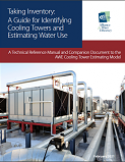Cooling Technologies Project

The Alliance for Water Efficiency’s Cooling Technologies Study was initiated by the AWE Water Efficiency Research Committee after it identified cooling tower water efficiency as an area of needed research. The project began in early 2020 and was completed in the Fall of 2022. AWE worked with the Pacific Northwest National Lab and Maureen Erbeznik & Associates to develop tools and resources to help AWE members create, or optimize, cooling tower water efficiency programs.
To view the April 2021 webinar outlining the research focus, project goals, and eventual resources, click here.
To view the November 2022 webinar reviewing the completed project and discussing the final resources, click here.
To view the information for the Alliance for Water Efficiency's first Learning Cohort focused on Cooling Technology, click here
Overview of Cooling Technology Resources
Below is a summary of each resource that was developed from this project, along with links to download the resource.
All Cooling Technology Studies Resources are member-only benefits. To view and download these resources, please visit The Cooling Technology Study Resources Page in the AWE Resource Libray.
The Cooling Tower Estimating Model
The Cooling Tower Estimating Model (CTEM) is an Excel-based tool that provides an estimated range of the number of water-cooled facilities, number of cooling towers, total cooling capacity, water use, and water conservation potential for a utility service area based on a minimal amount of input data. CTEM can also be used to develop a cooling tower inventory, a critical first step in creating or refining a cooling tower water efficiency program.
Base features of CTEM can be used with the following data inputs:
- Country (United States or Canada)
- State or Province
- County (for U.S. locations)
- Service Population
- Water Quality (measured in total dissolved solids (TDS) or conductivity)
Embedded within CTEM is the Water Quality Helper, which is a tool allows you to enter water quality parameters to identify factors that may be limiting the water efficiency of cooling towers (cycles of concentration) in your area, and direct you to potential solutions to improve water efficiency.
CTEM comes with a companion guide, Taking Inventory: A Guide for Identifying Cooling Towers and Estimating Water Use , which provides instruction on how to use the model, identify cooling towers, and initiate a cooling tower inventory.
The development of CTEM and this guide is a key step to increasing the effectiveness of incentive and outreach programs for the efficient use of cooling water. With CTEM estimates, suppliers can begin to understand the conservation potential in cooling towers, develop marketing and conservation efforts, and record facility participation.
How-To Guide, Creating a Cooling Tower Water Efficiency Program
The How-To Guide is an educational and practical resource for water supplier professionals exploring a water efficiency program focused on cooling towers. The guide includes are strategies to find properties with cooling towers and their respective decision makers, recommended outreach and sales processes, sample email templates and case studies, options for incentive structures and more.
The Cooling Tower Audit Tool and Simple Return on Investment Calculator
The Cooling Tower Audit Tool and Simple ROI Calculator is an Excel-based tool that can be used as a cooling tower audit template and as a screening tool to evaluate water savings opportunities while calculating a simple economic return on investment for treatment upgrades.
Comparing Alternatives Tool
The Comparing Alternatives Tool is an Excel-based model for estimating the water savings potential of four selected alternative water treatment technologies over time for a given utility’s service territory. The tool then compares the projected savings and overall impact of the selected technologies for two adoption rate scenarios in the Market Penetration module in the tool.
Alternative Technologies Report
The Alternative Technologies Report focuses on determining the water savings potential of different alternative cooling technologies. The report provides an overview of four selected alternative cooling technologies and estimates water savings using a model case study.
Cooling Technologies Study Project Summary
The Cooling Technologies Study Project Summary is a document that provides a general overview of the study as well as synopses for each of the study deliverables. The Project Summary is available to the public and can be downloaded at the link here.





